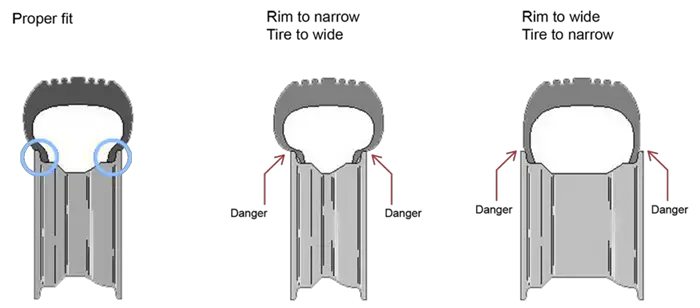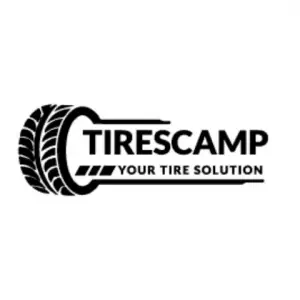One of car enthusiasts’ most commonly asked questions is whether putting a 12-inch tire on an 8-inch rim is possible. The simple answer to this question is yes. You can put a 12-inch tire on an 8-inch rim.
Occasionally, placing a tire 4 inches wider than the rim is possible. However, this is not advised by many manufacturers. Many suggest you choose a tire that is 1 to 2 inches wider than the rim. In that case, the maximum recommended tire width for an 8-inch rim is 245mm.
What are the Effects of Using Wider Tires on Your Car?
For both on- and off-road vehicles, increasing tire width, also known as the footprint or contact patch of a tire, may improve performance. Additionally, it’s not unusual for original equipment wheels to support wider tire sizes than stock.
However, fitting an excessively wide tire might lead to contact with various car parts, and minor to significant vehicle damage is likely.
- Contact with fender liner: The most typical point of contact for a significantly wide aftermarket tire fitment is the plastic liner that covers the wheel’s interior well. Some “rubbing” of the fender liner can happen under specific suspension compression circumstances or with a considerable steering angle. In some performance driving circles, a minor touch of the fender liner is occasionally accepted even though it is not advised or recommended.
- Vehicle body contact: while the fender liners are flexible, your car body panels that connect to the fender liners and wheel wells are not. Due to the possibility of tire or vehicle body damage, contact with these panels must be avoided.
- Contact with suspension elements: If the tire width is adequate to reach the spring and strut under specific compression circumstances, contact with these parts may occur. Under any driving case, a tire contacting these parts must be carefully avoided. Damage to the vehicle’s suspension and possibly seriously impact its ability to drive can happen.
- Contact with electrical components and wires: These are typically kept out of spinning tires’ reach. However, they may be reached depending on how wide the aftermarket tires are. It goes without saying what would happen if the tire tread “caught” any electrical cables or parts.
- Contact with fuel system parts: Just under the fender liners of many vehicles, a lot of crucial mechanical activity occurs. For instance, the wheel wells are sometimes used to route fuel system parts and lines that run fore and aft of the car. The wheel wells can also contain a variety of sensors and electronics. The fender liner serves as a barrier and protector against direct contact damage, but too much pressure applied through the liner may harm these parts.
Tire Too Wide Or To narrow Explain On Graph

Other Disadvantages of Wider Tires
Lower Fuel Economy
In general, the lower the friction a tire produces, the minimal the steering effort is required, thus lowering fuel consumption. Since wider tires lead to increased friction on the road, they increase fuel consumption.
Additionally, wider tires are heavier, so the engine must work harder. Naturally, they lead to increased fuel consumption as a result.
If you are one of the individuals who dislike spending much on fuel, then sticking to narrower tires would be the best thing.
Harder Steering and Slower Acceleration
Wider tires are heavy, and this increases a vehicle’s weight. The car’s acceleration is lowered as a result.
Additionally, these tires have more extensive contact surfaces, which decreases acceleration and contributes to stiff steering and inferior vehicle handling.
Short-Term Tire Wear
Because of the abovementioned problems, wider tires will wear out more quickly than narrow ones.
Speedometer Error
You are altering your car’s standard components by upgrading your tires. As a result, a car’s embedded technology may not be entirely accurate, leading to issues in the speedometer reading.
Pricey
Widder tires will undoubtedly cost more to produce. As a result, installation is more expensive. Also, since fewer options are available on the market, wider tires are more costly than narrow tires.
Do Wider Tires give You More Grip? Tyre Widths Tested and Explained (Must Watch Video)
Why Choose Widder Tires
Improved Traction and Grip
Increasing the contact with the road will improve traction. In this approach, wider tires provide more traction and grip because they give you a broader contact area.
Better Cornering
Widder tires provide better cornering and road handling due to the same factor of having a broader contact area with the road, as mentioned previously. Wider tires also have better thread and firmer sidewalls, which reduce vehicle roll in corners.
Improved Braking
If you upgrade to wider tires, your car will have more grip and contact area on the road. This results in a shorter stopping distance for your vehicle, especially on dry roads, and a better braking system overall.
Enhanced Aesthetics
The use of broader tires will also give your car a sportier appearance. As a result, the whole design is improved. Wider tires are popular among automobile owners today since they improve a vehicle’s appearance.
When to Use Widder Tires
It would be ideal to choose the right tire for your vehicle after considering the type of terrain you will be driving on. Here are two situations in which wide tires excel over narrow ones.
Wet Environment.
Wide wheels are the best for driving in the rain because they include sipes that help collect and drain water from the contact area.
There are sipes on narrow models, but there are fewer because of the small surface area.
Dry Roads
Consider buying wide wheels if you frequently drive on asphalt roads.
For this type of road surface, more surface area provides better grip as opposed to added pressure.
Are Wider Tires Better on Snow?
When driving in the winter, you require tires that can break through the snow to improve traction. Because they can sink further into the snow and offer more grip, the narrow tires perform better when the roads are covered with snow.
Wider tires with more sipes, however, will perform better on compacted snow.
What size tire will fit a 8 inch wide rim?
The recommended tire size for an 8 inch wide rim is between 215 and 245 millimeters in width. However, it is important to note that the tire width should not exceed the width of the rim, and that the tire size should also be compatible with the vehicle’s suspension and clearance. It is recommended to consult the vehicle’s owner’s manual or consult with a professional to ensure proper fit.
What is the narrowest tire that can fit on an 8 inch rim?
The narrowest tire that can fit on an 8 inch rim is typically around 185mm. However, it is important to note that the actual width of the tire that can fit on an 8 inch rim will vary depending on the specific tire and the manufacturer’s specifications. It is also important to consider the width of the rim, as a narrower rim will be able to accommodate a narrower tire. It is always best to consult the manufacturer’s specifications or consult with a professional to ensure proper fitment.
Final Take: 12-Inch Tire on 8-Inch Rim
It is possible to fit a 12-inch tire on an 8-inch rim. In most instances, you can fit a tire 4 inches wider than the rim. However, most car and tire manufacturers advise against this.

